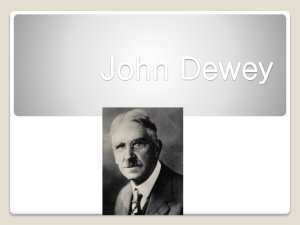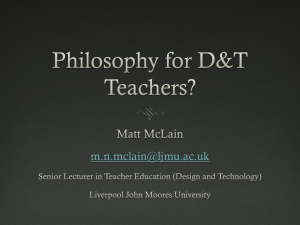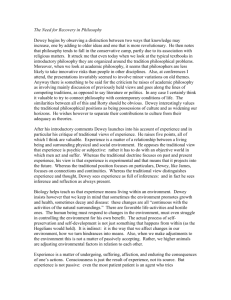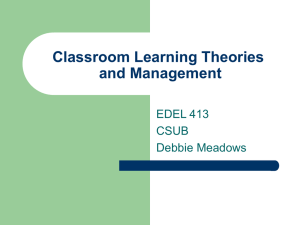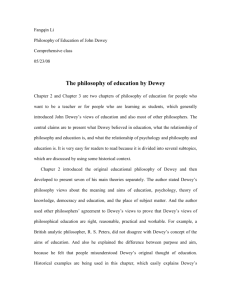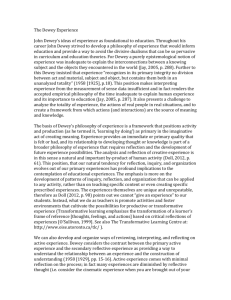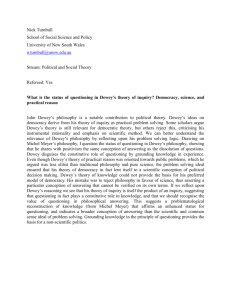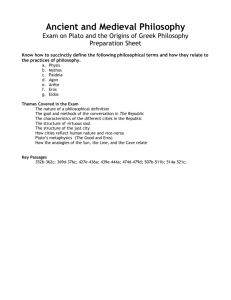The Origins of Metaphysics
advertisement
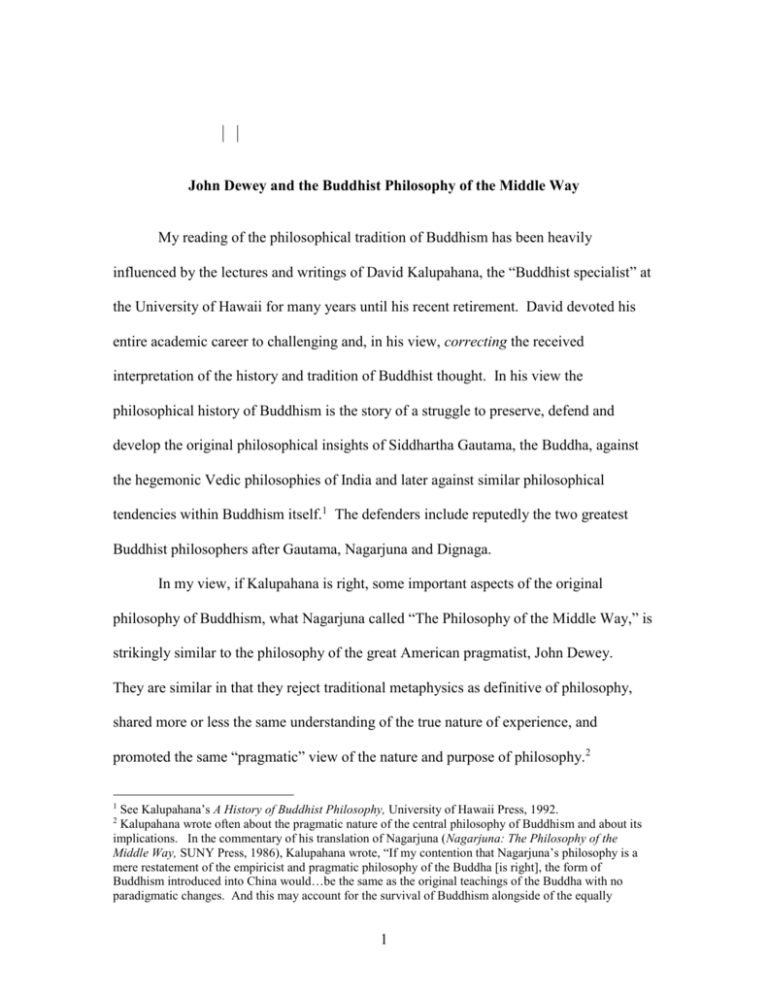
John Dewey and the Buddhist Philosophy of the Middle Way My reading of the philosophical tradition of Buddhism has been heavily influenced by the lectures and writings of David Kalupahana, the “Buddhist specialist” at the University of Hawaii for many years until his recent retirement. David devoted his entire academic career to challenging and, in his view, correcting the received interpretation of the history and tradition of Buddhist thought. In his view the philosophical history of Buddhism is the story of a struggle to preserve, defend and develop the original philosophical insights of Siddhartha Gautama, the Buddha, against the hegemonic Vedic philosophies of India and later against similar philosophical tendencies within Buddhism itself.1 The defenders include reputedly the two greatest Buddhist philosophers after Gautama, Nagarjuna and Dignaga. In my view, if Kalupahana is right, some important aspects of the original philosophy of Buddhism, what Nagarjuna called “The Philosophy of the Middle Way,” is strikingly similar to the philosophy of the great American pragmatist, John Dewey. They are similar in that they reject traditional metaphysics as definitive of philosophy, shared more or less the same understanding of the true nature of experience, and promoted the same “pragmatic” view of the nature and purpose of philosophy.2 See Kalupahana’s A History of Buddhist Philosophy, University of Hawaii Press, 1992. Kalupahana wrote often about the pragmatic nature of the central philosophy of Buddhism and about its implications. In the commentary of his translation of Nagarjuna (Nagarjuna: The Philosophy of the Middle Way, SUNY Press, 1986), Kalupahana wrote, “If my contention that Nagarjuna’s philosophy is a mere restatement of the empiricist and pragmatic philosophy of the Buddha [is right], the form of Buddhism introduced into China would…be the same as the original teachings of the Buddha with no paradigmatic changes. And this may account for the survival of Buddhism alongside of the equally 1 2 1 The Origins of Metaphysics We begin with the well-known text commonly referred to as “The Silence of the Buddha.” In that text, Gautama refuses to respond to what are clearly metaphysical questions: “Is the world eternal or not eternal?” “Is the soul and body identical or not identical?” “Is the world finite or infinite?” To each question, he answers, “I do not say.” Instead, he declares that “he is free from all theories “ (which I presume is different from being uncommitted to a theory), and then gives the dire and puzzling, melodramatic warning that any theory we hold with respect to these questions “is a jungle, a wilderness, a puppet-show, a writhing and a fetter, and is coupled with misery, ruin, despair, and agony.”3 What are we to make of the silence of the Buddha? The answer to the riddle, I believe, is contained in another authoritative text of Buddhism, “The Discourse to Kaccayana.” It is believed that the major work of the great Buddhist philosopher, Nagarjuna, Fundamental Verses of the Middle Way, is based on this discourse. In the last verse, Nagarjuna writes, “I prostrate to Gautama, who through compassion, taught the true doctrine, which leads to the relinquishing of all views.”4 Nagarjuna is undoubtedly referring to the “Discourse to Kacccayana,” in which this venerable elder of the village asked of Gautama, “people speak of “right view, right view.” To what extent is there a right view?” And Gautama replies: This world [meaning human beings] is generally inclined towards two views; existence and non-existence [sat and asat]. To him who perceives with right wisdom the uprising of the world as it has come to be, the notion of non-existence in the world does not occur. To him who perceives with right wisdom the ceasing of the world as it has come to be, the notion of existence in the world does not pragmatic philosophy of Confucianism, whereas it failed to survive in India in the face of a very strong idealistic tradition.” (p. 8) 3 Majjhima-nikaya i.483-8, in H.C. Warren, Buddhism in Translation, pp. 123-8 4 Nagarjuna, The Philosophy of the Middle Way, trans. By David Kalupahana, State University of New Press, 1986. 2 occur. The world for the most part is bound by approach, grasping and inclination. And he who does not follow that approach and grasping, that determination of mind, that inclination and disposition, who does not cling to or adhere to a view…such a person does not doubt, is not perplexed. His knowledge is not other-dependent. Thus far, Kaccayana, there is “right view.” “Everything exists,”—this is one extreme. “Everything does not exist,”—this is the second extreme. Without approaching either extreme, I teach you a doctrine of the middle.5 The doctrine that he then proceeds to expound is the doctrine of pratityasamutpada (the doctrine of dependent origination): “Dependent upon ignorance arise dispositions; dependent upon dispositions arise consciousness; dependent upon consciousness arises the psychophysical personality, [and so forth]…However, from the utter fading away and ceasing of ignorance, there is ceasing of dispositions, etc.” The general doctrine itself is formulated by Gautama as follows: “When that exists, this comes to be; on the arising of that, this arises. When that does not exist, this does not come to be; on the cessation of that, this ceases.” What exactly is the meaning of the doctrine of dependent origination, this doctrine of the middle, and how will understanding it free a person from trying to find the right answer to such questions as does the soul exist or not exists, is there a first cause or not a first cause, does life have a purpose or not, and so on? And why is this teaching not just another view, or is there a difference, in Gautama’s mind, between a view and a doctrine? We must first try to understand how the world came to be bound by this “determination of mind, inclination, and disposition” in the first place; this obsession with what is the right view, this obsession with metaphysical questions that leaves one “perplexed and grasping.” Gautama long ago saw that the answer lies in a fundamental and indisputable fact about human existence, when he declares, “it remains a fact and the 5 Samutta-nikaya, in Kalupahana’s translation of Nagarjuna: The Philosophy of the Middle Way, pp. 10-11. 3 fixed and necessary constitution of being that all its constituents are anitya (transitory, ever changing, unpredictable).”6 It is a testimony to the allure of metaphysics, the power of the obsession, that this declaration itself has been wrongly taken to be a metaphysical statement about the ultimate nature of reality, misinterpreted particularly by some later Buddhist philosophers who strayed from the middle way. I believe that John Dewey is talking about anitya, this fact of human existence, in the chapters “Escape from Peril” from The Quest for Certainty (his Gifford Lectures) and “Existence as Precarious and Stable” from Experience and Nature (his Carus Lectures), and elsewhere. To say that existence is anitya is to say, in Dewey’s words, that we live in an aleatory world. “The world,” Dewey tells us, “is a scene of risk; it is uncertain, unstable, uncannily unstable. It’s dangers are irregular, inconstant, not to be counted upon as to their times and seasons…Plague, famine, failure of crop, disease, death, defeat in battle, are always around the corner, and so are abundance, strength, victory, festival and song.”7 Because the world is neither total chaos nor totally fixed and orderly, but an “inextricable mixture of stability and uncertainty,” human existence is like a lottery, a gamble. Our existence is precarious to varying degrees because we are essentially creatures living not merely in an environment, but by means of an environment. Our living occurs not merely under certain conditions, we live within these conditions; we are not only in the world, we are of the world.8 That we are of the world, I contend, is the implication of Gautama’s declaration that “it remains a fact and the fixed and necessary 6 Anguttara-nikaya iii,134; in H.C. Warren, Buddhism in Translations, Harvard Oriental Series, 3, sixth issue (Cambridge, Mass: Harvard University Press, 1915), Foreword 7 John Dewey, Experience and Nature, New York: Dover Publications, 1958, p. 41. 8 As Dewey says, “”Environment” is not something around and about human activities in an external sense; it is their medium or milieu, in the sense in which a medium is inter-mediate in the execution or carrying out of human activities, as well as the channel through which they move and the vehicle by which they go on.” (Knowing and the Known, The Late Works 16:248) 4 constitution of being, that all its elements are lacking in an ego.”9 In other words, we are not a substantive self (atman) that is capable of transcending the natural conditions of our existence. Lacking tools and other means of protection, Dewey believes that the first response of human creatures to the predicament of being at the mercy of an aleatory world is to seek some kind of control through supplication to the hidden powers imagined to exist behind nature. Over time, this strategy of supplication became systematized and socially generalized. That is to say, there arose a communal way of conceiving of life and the world, a picture of our place in the universe and a vision of the meaning and significance of human life. But as traditional belief cannot continue to rely on the force of habit and custom for justification, there was a need, as Dewey put it, “to develop a method of rational investigation…which should place the essential elements of traditional belief upon an unshakable basis.”10 This is the method followed by the Vedic philosophers of India and the philosophers of ancient Greece. Thus it is that, Dewey writes, Philosophy has arrogated to itself the office of demonstrating the existence of a transcendent, absolute or inner reality and of revealing to man the nature and features of this higher reality.11 [And] philosophical doctrines, which disagreed about virtually everything else, were at one in the assumption that their distinctive concern as philosophy was to See footnote 6. Dewey is very “Confucian” in this regard, seeing that everything that makes up the self— beliefs, values, meanings, and so on—are socially formed. Fully aware that he is opposing the dominant view of Western thought, he contends, “The underlying philosophy and psychology of earlier liberalism led to a conception of individuality as something ready-made, already possessed, and needing only the removal of certain legal restrictions to come into full play. It is not conceived as a moving thing, something that is attained only by continuous growth. Because of this failure, the dependence in fact of individuals upon social conditions was made little of…social arrangements and institutions were thought of as things that operate from without, not entering in any significant way into the internal make-up of individuals.” (Liberalism and Social Action, The Late Works, 11:30. 10 “Reconstruction in Philosophy,” The Middle Works, 12:89. 11 Ibid., 12: 92. 9 5 search for the immutable and ultimate—that which is—without respect to the temporal or spatial.12 From that time on, those who oppose this philosophical enterprise (the view of “existence”), including the pragmatists, were labeled skeptics and relativists (the view of “non-existence”). The Origins of Pragmatism But Dewey argued that human creatures actually devised two strategies for control in an aleatory world: the strategy of supplication that mutated into classical metaphysics and what Dewey called the strategy of science and technology. This second mode of response involves, Dewey says, turning “the powers of nature to account” by “changing the world through action.”13 Humans, in other words, learned to transform conditions to better suit their needs. Along with the development of the practical arts of tool making, agriculture, and hunting, this response gave rise to a stock of common-sense beliefs about the world. And, most importantly, it promoted “the development of the experimental habit of mind.”14 When Dewey contends that “just this predicament of the inextricable mixture of stability and uncertainty gives rise to philosophy,”15 he is referring to the two different conceptions of the nature and purpose of philosophy that emerge from the two different strategies of coping with an aleatory world. The strategy of supplication gave rise to the traditional conception of philosophy, as what Dewey calls, “the search for the immutable.” The aim of this idea of philosophy, as Plato declared authoritatively, is the knowledge of the (capitalized) One, the True, and the Good. It is concerned with the 12 Ibid., 12: 260. “The Quest for Certainty,” The Later Works, 4:3. 14 “Reconstruction in Philosophy,” The Middle Works, 12:85-86. 15 “Existence as Precarious and Stable” in Experience and Nature, The Late Works 1:46 13 6 universal and unchanging principles of knowledge, morality, and being that are supposed to govern the changing world in which we live. Philosophy is thus conceived as a kind of “super science” concerned with the knowledge of being, of the way things really are as opposed to how they appear to be. And philosophers are to be the high priests of culture. The pragmatic conception that emerged from the second strategy is based, Dewey claims, on the crucial insight that thinking and philosophy “is no different in kind from the [intelligent] use of natural materials and energies, say fire and tools, to refine, reorder, and shape other natural materials.” The focus is on the problems we encounter in the actual world. The second strategy therefore gives rise to a conception of philosophy as critical and reflective thinking about experience with the aim, Dewey says, of “transforming confusion, ambiguity and discrepancy into illumination, definiteness, and consistency.”16 Dewey gives just this definition of philosophy in the syllabus for an introduction to philosophy course he taught in 1892 at Michigan, at the beginning of his career: Philosophy (science) is the conscious inquiry into experience. It is the attempt of experience to attain its own validity and fullness: the realization of the meaning of experience. Science and philosophy can only report the actual conditions of life, or experience. Their business is to reveal experience in its truth, its reality. They state what is. The only distinction between science and philosophy is that the latter reports the more generic (the wider) features of life; the former the more detailed and specific.17 Experience and “Radical” Empiricism I will argue that Gautama also subscribes to this second conception of philosophy, but what is the significance of the seemingly innocuous contention that the subject matter of philosophy is experience and its problems? It is first of all a way of saying that 16 17 Ibid., 1:18 John Dewey: The Early Works. 7 philosophy must proceed in a radically empiricistic manner, following what Dewey calls the “empirical, denotative method;” for both pragmatism and Buddhism are indeed committed to the principle that all knowledge comes through (not from) experience. But to understand exactly what this means, it is essential that we recover the common, authentic use of the term, “experience.” As Dewey says, “To know the meaning of empiricism, we need to understand what experience is.”18 It is clear to Dewey that “traditional accounts of experience [from Hume, Locke, and Berkeley on down] have not been empirical, but have been deductions [that is, inferences], from unnamed premises of what experience must be…it has served ideas forced into experience, not gathered from it;” and, we may add, mired philosophers for generations in the so-called “problems of knowledge.”19 In particular, traditional empiricism “starts with a reflective product as if it were primary, as if it were the originally “given.””20 The truth is that, contrary to the tradition, experience is not the passive reception of some kind of data, and we are not mere spectators. It makes sense to say that philosophy is “the conscious inquiry into experience” only because, Dewey argues, [T]he value of the notion of experience for philosophical reflection is that it denotes both the field, the sun and clouds and rain, seeds, and harvest, and the man who labors, who plans, invents, uses, suffers, and enjoys. Experience denotes what is experienced, the world of events and persons; and it denotes that world caught up into experiencing, the career and destiny of mankind. Nature’s place in man is no less significant than man’s place in nature. Man in nature is man subjected; nature in man, recognized and used, is intelligence and art.21 “Experience and Education,” The Later Works, 13:11. The Middle Works, 10:11 20 “Experience and Philosophic Method,” in Experience and Nature, John Dewey, The Later Works 19251953, 1:19 21 “Appendix 2: Experience and Philosophic Method,” The Later Works 1:384. 18 19 8 Experience for Dewey is a continuous transaction with elements of our environment. It is not to be understood in terms of what a subject, a mind, is undergoing or in terms of the interaction between a subject and object that exist separate in their interaction. As John Stuhr puts it so well, “experience is an activity in which subject and object are unified and constituted as partial features and relations within this ongoing, unanalyzed unity.”22 Of course, what we are primarily experiencing are scraped knees, umbrellas, orders from the boss, dancing partners, fajitas, the June rains in San Antonio, and so on. But the experience itself is not a discrete cognitive episode or a series of such episodes, episodes of knowing, for the things that we experience are to be treated, used, acted upon, acted with, enjoyed, or endured.23 Experience is a continuous affair of simultaneous doings and sufferings. “It includes,” Dewey explains, “what men do and suffer, what they strive for, love, believe and endure, and also how men act and are acted upon, the ways in which they do and suffer, desire and enjoy, see, believe, imagine—in short, processes of experiencing.”24 Dewey makes the crucial point that “reference to the primacy and ultimacy of the material of ordinary experience protects us from creating artificial problems which deflect the energy and attention of philosophers from the real problems that arise out of actual subject matter.”25 In particular, the “material of ordinary experience” does not consist only of discrete elements or objects, but also of continuities and connections “Introduction by John Stuhr” in Pragmatism and Classical American Philosophy, 2nd edition, ed. by John Stuhr, Oxford University Press, 2000. p. 437. 23 I freely borrow these examples from my friend and former colleague, John P. Murphy, whose career was cut short by cancer. These examples and a very lucid discussion of Dewey’s view of experience can be found in his book, Pragmatism: From Peirce to Davidson (Westview Press, 1990). The book was published posthumously and was edited by Richard Rorty, who also wrote the introduction to the book. 24 “Experience and Philosophic Method,” in Experience and Nature, John Dewey: The Later Works, 19251953, 1:17. 25 Ibid., 1: 26. 22 9 inherent in the experience. Traditional empiricists obviously have not attended to the “material of ordinary experience,” for they have generated a dualism of experience (the procession of mental images) and “thinking” or “inference,” the latter performed by a separate faculty of the mind. The truth is that there is no conscious experience without inference, for inference is an operation within experience of directing behavior. This is, in other words, “man in nature.” Buddhist philosophers understood this and have been known to propound the socalled “theory of perception as inference.” Unfortunately the theory was taken by opponents to be saying that what we perceive is determined by the constructs and ideas of the mind, thus the charge that this theory leads to idealism. But this cannot be the case, since Buddhists, like pragmatists, reject the metaphysical dualism of subject and object, the self and the world; and by implication the distinction between the “cultural” and the “natural,” what Donald Davidson calls the “scheme-content” dualism. Experience is also “nature in man.” As Dewey says, It is not experience which is experienced, but nature—stones, plants, animals, diseases, health, temperature, electricity, and so on. Things interacting in certain ways are experienced; they are what is experienced. Linked in certain ways with another natural object—the human organism—they are how things are experienced as well. Experience thus reaches down into nature. It has depth.26 The nature of experience is such that it is impossible not to be in touch with a real, objective world, even if that world is not fixed once and for all. Dewey sums it all up in the statement, “the chief characteristic trait of the pragmatic notion of reality [what has been called his metaphysics of experience] is precisely that no theory of Reality in general, uberhaupt, is possible or needed…[because] reality is a denotative term, a word 26 Ibid., 1: 12. 10 used to designate indifferently everything that happens.”27 And this seems to be partly what Gautama is getting at when he says, “If we “perceive with right wisdom the uprising and ceasing of the world, the notions of existence or non-existence would not occur.” Pratityasamutpada and the Pragmatic Method Both Dewey and Gautama sought to emancipate philosophy from, in Dewey’s words, “too intimate and exclusive attachment to traditional problems.”28 Gautama called it an obsession. These problems, that philosophers proudly call “philosophical problems” (like the mind-body problem, the problem of the existence of the external world, the realism-idealism debate, and so forth) are in reality intra-theoretical problems, problems that arise within and because of the theories that philosophers came up with about things like experience, self, causality, to mention a few. They are academic problems and traditional philosophical debates are “family quarrels.” They are not what Dewey calls “the problems of men,” which really means problems that arise out of the experience of men, out of human experience, whose solutions would have “practical value,” the values of “transforming confusion, ambiguity and discrepancy into illumination, definiteness, and consistency.” “Problems of men” can be, for example, problems about the nature of the world in which we live, about the values that should guide our lives, about the nature and possibilities of knowledge, and about the scope and variety of human experiences. The crucial difference between traditional philosophy and pragmatism is that the latter fully embraces the method of radical empiricism, a method that requires the acceptance of what Dewey calls the postulate of immediate empiricism: “postulate that 27 28 “The Need for a Recovery of Philosophy” in John Dewey: The Middle Works, 1899-1924, 10:37. Ibid., 10:5. 11 things—anything, everything, in the ordinary and non-technical use of the term “thing”— are what they are experienced as. Hence, if one wishes to describe anything truly, his task is to tell what it is experienced as being.”29 In other words, Dewey is saying to the philosopher, “if you wish to find out what subjective, objective, physical, mental, cosmic, psychic, cause, substance, purpose, activity, evil, being, quality—any philosophic term, in short—means, go to experience and see what it is experienced as.”30 Dewey acknowledges that this method is not glamorous. “It is not spectacular,” he says, “it permits of no offhand demonstrations of God, freedom, immortality, nor of the exclusive reality of matter, or ideas, or consciousness, etc. But it supplies a way of telling what all these terms means.”31 The results of empirical inquiry are “specifically experienced meanings,” not esoteric concepts. Nagarjuna is employing the method of radical empiricism in his book Fundamental Verses of the Middle Way, but he calls it pratityasamutpada. He follows it in the examination of such phenomena as motion and rest, time, self, birth and death, the four noble truths, and of course, most famous of all, causality. In chapter one, he engages philosophers who worried about what we are talking about when we talk about causes, about one thing being the cause of another. They worried that there is no such thing as a cause and effect relationship, no objective matter of fact behind our causal discourse. Nagarjuna is famous for his criticisms of the many theories put forth to explain what causality really is. He took apart in a brilliant manner the attempts of various philosophers to prove the existence of such unobservable things as “necessary conditions” and “causal powers,” and then in verse four of chapter one, he said: “power “The Postulate of Immediate Empiricism” in John Dewey: The Middle Works, 1899-1924, 3:158. Ibid., 3:166. 31 Ibid., 3:166. 29 30 12 to act does not have conditions. There is no power to act without conditions. There are no conditions without power to act. Nor do they have the power to act.” For example, to explain the lighting of a match, we cite the striking of the match because “there is no power to act without conditions.” That is to say, talk about power to act only arises in the context of the perceived causal efficacy of one or more conditions. So we say, “the match will light if it is struck” or “whenever a match is struck it will light.” “Whenever this occurs, that will occur.” This is all that we can mean by the idea of cause and effect, and we arrived at this idea by experiencing the heat or burning of fire, the sounds of animals, the breaking of glass by hard objects, and so forth. What verse four warns about is confusing a functional property of the causal conditions with an existing, essential property, called “power to act.” So, Nagarjuna says, we observe conditions having the power to act, but no conditions have the power to act, because we do not observe any power to act in the conditions.32 Therefore, the philosophical belief about causation as a hidden power in things or as a necessary connection between events is, according to Nagarjuna, a samkalpa (“mental fabrication”) and a prapanca (“obsession” according to Kalupahana or “phenomenal extension” according to Frederick Streng).33 Calling it a samkalpa is to say that there is no empirical support, nothing in our experience to even suggest causal powers or necessary connections. Calling it a prapanca locates the source of the idea in our desire to “go beyond” the ordinary use of the term, to leave the “home” of the notion in our experiential world. I present this interpretation of Nagarjuna in my paper, “Nagarjuna’s Fundamental Principle of Pratityasamutpada,” in Philosophy East & West, Vol. 51, No. 1, January 2001. However, at that time, I did not make the connection with pragmatism. 33 See Frederick Streng, “The Significance of Pratityasamutpada,” in Mervyn Sprung, ed., The Problem of Two Truths in Buddhism and Vedanta (Dordrecht and Boston: D. Reidel, 1973), 7 32 13 It is in this context that Nagarjuna invokes his controversial notions of sunya and sunyata, empty and emptiness. He declares that “the Victorious ones have announced that emptiness is the relinquishing of all views,” but he is fully aware of the resilience and attraction of the picture of philosophy that has held us captive. He realizes that even his claim that “all this is sunya” can be misinterpreted. So, he warns that “those who are possessed of the view of emptiness are said to be incorrigible,” and that to assume that he is propounding a theory of reality is like grasping a snake by the wrong end.34 This is what so many commentators have done. So it is that Nagarjuna, the faithful follower of Gautama, has been portrayed as a nihilist, a conventionalist, a relativist, and an antirealist. He is none of these. He is, like Gautama, a pragmatist. Ewing Chinn Department of Philosophy Trinity University San Antonio, Texas 34 David J. Kalupahana, Nagarjuna: The Philosophy of the Middle Way (State University of New York Press, 1986) The passage, 24:11, goes like this: “A wrongly perceived emptiness ruins a person of meager intelligence. It is like a snake that is wrongly grasped or knowledge that is wrongly cultivated.” 14
